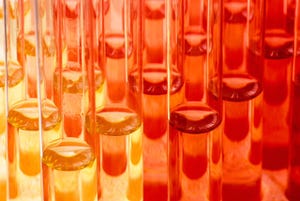Novel Carbon Supercapacitor Material Has Batterylike Energy Density
May 16, 2011
Scientists at the U.S. Department of Energy's Brookhaven National Laboratory (Upton, NY) have helped to uncover the nanoscale structure of a novel form of carbon, contributing to an explanation of why this new material acts like a superabsorbent sponge that can soak up electric charge.
Created by researchers at the University of Texas at Austin (UT Austin), the material can be incorporated into supercapacitor energy-storage devices with very high storage capacity while retaining other attractive attributes, such as superfast energy release, quick recharge time, and a lifetime of at least 10,000 charge/discharge cycles. The scientists believe that the energy source could eventually find its way into consumer devices, and medical device applications might not be far behind.
|
A new carbon supercapacitor material developed by scientists at the University of Texas at Austin could have a major impact on energy storage and energy conversion. |
Like batteries, supercapacitors store electric charge. Batteries do so through chemical reactions between metallic electrodes and a liquid electrolyte. Because these chemicals take time to react, batteries store and release energy relatively slowly. However, batteries can store a great deal of energy and release it over a fairly long period of time. Supercapacitors, on the other hand, store charge in the form of ions on the surface of the electrodes. Charging the electrodes causes ions in the electrolyte to separate, or polarize, enabling charge to be stored at the interface between the electrodes and the electrolyte. Pores in the electrode increase the surface area over which the electrolyte can flow and interact, increasing the amount of energy that can be stored.
Because most supercapacitors hold far less charge than batteries, their use has been limited to applications in which smaller amounts of energy or a long life cycle are needed. The UT Austin researchers' new material, in contrast, has an energy-storage capacity, or energy density, similar to that of lead-acid batteries. And like supercapacitors, they release energy rapidly.
Aware that the UT scientists' considered their material to consist of a continuous 3-D porous network with single-atom-thick walls with a significant fraction being "negative curvature carbon," the Brookhaven team characterized the supercapacitor's structure at the nanoscale. They concluded that the material is indeed a 3-D nanoscale structure consisting of a network of highly curved, single-atom-thick walls that form tiny pores with widths ranging from 1 to 5 nm.
The scientists say the processing techniques used to create the new form of carbon are readily scalable to industrial production. "This material, being so easily manufactured from one of the most abundant elements in the universe, will have broad-range impacts on research and technology in both energy storage and energy conversion," UT lead scientist Rodney Ruoff comments.
About the Author(s)
You May Also Like



